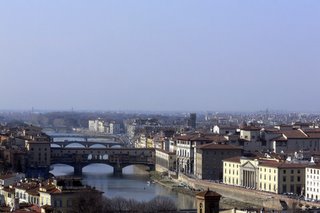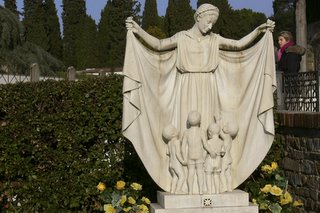
This past week has been both a busy and yet relaxing seven days. The weather continues to be wonderful (sorry you Northeasterners) with sunny days, clear nights, with temperatures on the chilly side but perfect for urban trekking. (You can see find photos of this day’s outing online – just click here.)
Susan’s school is going well (see the entry “School days” for her observations after the first two weeks in class) and we have begun exploring more of Florence. Monday through Thursday are pretty routine, going to the market, (Susan) going to school, and just hanging out in our neighborhood, exploring some of the nearby side streets, that sort of thing.
On Friday, however, with Susan not having to go to school everything shifts into a different gear altogether. This past Friday was another gorgeous day, sunny although a bit chilly in the shade when we walked a couple of blocks over to the Museum of San Marco, located next to, surprise, the church of San Marco and just off, you got it, the Piazza San Marco, and spent the morning viewing the paintings of Fra Angelico.
A Dominican friar, Guido di Pietro, better known in the West as Fra Angelico, painted some of the most gorgeous work during the late medieval, early Renaissance period. Or in the words of one art critic: “His visages have an air of rapt suavity, devotional fervency and beaming esoteric consciousness, which is intensely attractive to some minds and realizes beyond rivalry a particular ideal—that of ecclesiastical saintliness and detachment from secular fret and turmoil.” (From the Wikipedia.)
I guess that says it all for me. I mean I often feel detached from “secular fret” myself.
After viewing Fra Angelico’s work – along with works by some of the other lesser-known friars who came and went through San Marco monastery we then went upstairs to view the former cells of the monks, and one in particular, Girolamo Savonarola. A sworn enemy of the Medici’s and a driving force behind urging Florence to expel the Medicis from the city in order to institute a more socially responsible government, the Dominican priest Savonarola let extremism get the best of him, and he was eventually hanged on the Piazza Signoria and his body burnt and ashes thrown into the Arno. Today you can see the spot where a plaque commemorates the site of the execution in the Piazza Signoria -- just look for a large group of tourists all standing in a circle looking down, rather than up at the statues.
In the afternoon we took our guidebook (Florence: Guide for the curious traveller, pubhttp://www.blogger.com/img/gl.link.giflished by Mandragora) and set out for the Piazzale Michelangelo, located just southeast of the city. Our objectives were to be out in the sun, to walk some of the side streets of the “Oltrarno”, the city south of the Arno, and get some great views of the city. Well we did that but we found much more along the way.

We crossed the Arno at the Ponte Vecchio (“old bridge”, but also loosely translated from the Italian as “big money”). In 1593 the bridge became the sole province of the goldsmiths (it had been previously occupied by butchers so I guess little really changed) and it has remained so ever since.
In fact one of the city’s most famous goldsmiths was the sculptor Benvenuto Cellini and his bust sits midway across the bridge. However, the city government has recently placed a metal fence around the bust. This reportedly is designed to prevent the continuing fad of lovers locking padlocks with their names scratched on them onto the small wrought iron fence around the statue and then of course they throw the key into the river, signifying their undying love I suppose.
So after we crossed the Arno we turned east heading upriver and after a short while turned south away from the river and began our climb up toward Piazzale Michelangelo, a steep but fascinating hike through small gardens walking on a series of steps called the Via di Crocis (“street of the crosses”) created by a group of Fransiscan monks from the church of San Salvatore, which is at the top of the hill just behind the Piazzale. And yes there were small wooden crosses, each about 5 feet high lining the entire path.

At last we arrived at the Piazzale and spent some time taking in the stunning views of the city.
We then turned away from the city and walked to the church of San Salvatore al Monte and then over to the nearby the church of San Miniato al Monte, all located, as their names suggest a the hill which overlooks the city. (While we can only take one museum of Madonnas a day we can handle at least several churches daily.)
We wandered down a path and from San Salvatore and couldn’t quite see the next church through the trees so we stopped a friar walking down the street and ask directions: “dov’e la Chiesa San Miniato?” He pointed toward the trees ahead of us and said “dietro” (behind). So we walked 100 meters or so through the woods – in fact through a “garden of remembrance” to men and women from the Italian Red Cross who perished in World Wars One and Two. The garden was filled with cypress tress, each bearing a small plague with the name of one of the fallen volunteers. We continued our walk up a small rise, through a gate and into an enormous cemetery (“cimitero”).

Now most guidebooks rarely bring up cemeteries as a place to visit. That is unless, one can identify particular celebrities, or famous persons who might be buried there, such as in the Protestant cemetery in Rome or Arlington National Cemetery in Washington, DC. Anyway few guidebooks on Florence mention the Delle Porte Sante cemetery (laid out in 1854) in other than passing fashion. This is really quite a shame since this particular place is an absolutely fantastic outdoor sculpture garden. Among the people buried there is Carlo Collodi, the guy who created Pinocchio.

But it is much, much more than just sculpture. Wandering among the stones you can see profound sentimentality, tragic love and nostalgia.
You might also get a hint at what the tombs were like which once lined the Appian Way.

One can also get a sense for the strength of feeling Florentine society has for its very personal history, a history written in the lives and loves and deaths of its citizens, mostly unknown men, women and children, who went about their daily lives doing what our species has always done, simply trying to enjoy life for as long as possible.

In the Capitoline museum in Rome is a room filled with the busts of nameless Romans, but with faces that betray their connections with the rest of us: fat, thin, worrisome, happy, smiling, all very lifelike in their portrayal of the subject. So too in Delle Porte Sante: busts of men and women striving to depict in stone the deceased as he or she hoped to be remembered.
Each stone tells a tale, a story as interesting as anything found in the Decameron by Giovanni Boccaccio. One example of just such a story is the love affair of Maria and Mario Mazzone.

Maria Grazia Collela was born in 12 February, 1922, and Mario Mazzone was born 28 November, 1919, and sometime during the Second World War they were married, possibly in Florence. Mario was a radio operator in the Regia Aeronautica (the Italian Air force), and died on 22 July, 1944, in or near Hamm, Germany. In September of 1943 the Italians ousted Mussolini from power and switched sides, joining the Allies in their war against Germany and Japan. So why was Mario in Hamm, Germany, some ten months later? Was he one of the units that remained loyal to the Germans? Or was he one of the many Italians taken as POWS by the Germans when Italy switched sides? We do know that on the day Mario died a group of U.S. B-24 bombers struck the rail yards at Hamm, Germany, inflicting serious damage. Was he killed during that raid?
And his widow? Maria died on 31 May, 1945, barely ten months after Mario’s death.

In a cemetery filled with sculpture, and with busts of the long departed, this life-size pair of statues is truly unique. But who arranged for the statues to be placed in the cemetery? Can it be assumed that both husband and wife were reunited in this one spot for eternity?
One thing is for certain: they will forever be young and in love, smiling, and happy.
We then went into the church and were immediately struck by its unique layout and interior décor: it was on three levels, each easily seen and readily accessible from either side of the church. (To see photos of the church – not mine by the way – click here.) And they were also tuning the huge organ in the church, which added to the atmosphere.

After we left the church we continued our stroll through the lovely park-like atmosphere on the hills overlooking Florence. We then turned down Via San Leonardo, a wonderful little surprise, a narrow curving road, which eventually led us back inside the city.

Just before we returned to the banks of the Arno we passed by the house of Galileo. Odd to think of what things these streets have seen and heard over the last several centuries -- what will they hear and see in centuries to come I wonder?
A wonderful day to be alive.
Wish you were here.
Ciao,
Steve
No comments:
Post a Comment